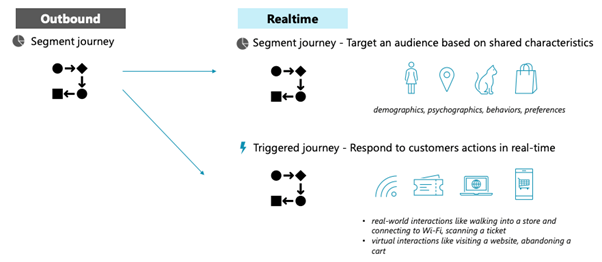Note
Access to this page requires authorization. You can try signing in or changing directories.
Access to this page requires authorization. You can try changing directories.
Important
The outbound marketing module is gradually being removed from Customer Insights - Journeys. To avoid interruptions, stop using outbound marketing and transition to real-time journeys. Learn more: Transition overview.
The playbook for transitioning from outbound marketing to real-time journeys suggests looking at logical marketing campaigns that might contain many different marketing artifacts like segments, emails, and journeys. It's also important to know how the different building blocks in outbound can be transitioned or implemented in real-time journeys.
This article explores some general concepts to think about before diving into transition details for individual feature areas.
Don't approach tasks as if you're working in outbound marketing; think real-time
Real-time journeys can accomplish almost all of the tasks that outbound marketing can. It also has many features beyond outbound marketing's capabilities. A typical outbound journey looks like this:
- Start with a segment of specific contacts
- Send a first e-mail
- Monitor different events like “email delivered” or “e-mail opened”
- React to specific events in the email, for example “button clicked” and use branches to direct the contact to a specific landing page
You can implement this same workflow using real-time journeys (see Send a targeted email blast in Customer Insights - Journeys). However, the playbook suggests using a slightly different mindset. A major benefit of the real-time journeys module is the ability to work with real-time event triggers. These triggers allow you to use nearly any event (Dataverse, external system) to trigger a journey (see Identify and resolve errors with real-time customer care journeys).

Feature differences
Although Microsoft releases new additions to the real-time journeys module every month, there are still some features that exist in outbound marketing that aren't available in real-time journeys. Microsoft develops new functionality based on customer feedback. The result is that some features aren't scoped for real-time journeys, but often the same goal can be achieved differently in real-time journeys. The "Transition functional areas" sections of this guide walk through different feature areas and discuss any parity gaps.
Because the real-time journeys module is a new development and has no relation to outbound marketing from a technology perspective, there's no plan to have a 1:1 feature parity. Typically, requirements can be addressed in a different way in real-time journeys. If you're concerned about feature parity, make sure to take a close look at the "Transition functional areas" articles linked below to learn ways features are implemented in real-time journeys.
Transition functional areas articles:
- Setup changes in real-time journeys
- Segments, emails, and journeys
- Consent
- Marketing pages and forms
- Event management
- Lead management and scoring
- Insights and reports
- Social posts
Outbound marketing customizations
Some Dynamics 365 Marketing customers made customizations in outbound marketing tables like “e-mail” or “customer journey” in order to meet specific requirements. In some cases, the real-time journeys module uses its own tables to provide the functionality (for example, in email and journeys), while in other cases, it retains the same tables (for example, event planning tables). Tables like “e-mail” or “journey” are also customizable and new fields will also show up in the user interface. However, it's recommended to first look at the out-of-the-box capabilities. Many requirements that created a new for customization in the past can now be addressed by standard features.
In most scenarios, it's not possible to transfer outbound marketing customizations. Dynamics 365 Marketing customers are advised to review their requirements and consider that previous customizations may no longer be needed due to the enhancements provided by real-time journeys. Where customizations are still required, it's likely that they'll need to be reimplemented (for example, custom fields readded).
Hide outbound marketing
When you're finished migrating to real-time journeys from outbound marketing, you can clean up the user experience by hiding outbound marketing. In the area switcher, choose Settings and then Versions where you'll see a button to Hide outbound marketing. Selecting this button hides outbound marketing from the user experience so your team can no longer navigate to the module and spin up new content or journeys there.
What happens when outbound marketing is removed by Microsoft?
When outbound marketing is formally retired, Microsoft will clean up the services in the background. To understand the details of exactly what will be cleaned up and what happens to your data, see Real-time journeys transition FAQs.